The Richest 20 Percent of U.s. Families Earn

Ascent economic inequality in the The states has become a central issue in the race for the Democratic presidential nomination, and discussions about policy interventions that might help address it are likely to remain at the forefront in the 2020 general election.
As these debates proceed, here are some basic facts virtually how economic inequality has changed over fourth dimension and how the U.S. compares globally.
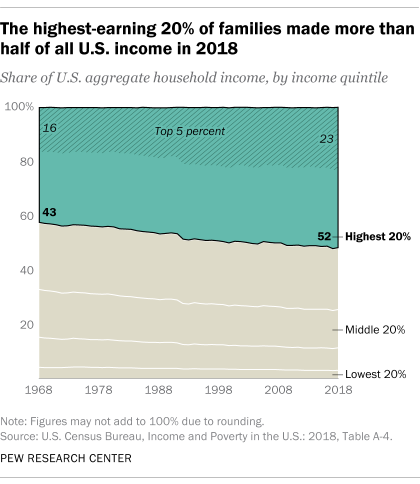
Over the past fifty years, the highest-earning twenty% of U.S. households have steadily brought in a larger share of the country's full income. In 2018, households in the top fifth of earners (with incomes of $130,001 or more than that year) brought in 52% of all U.S. income, more the lower four-fifths combined, according to Demography Agency data.
In 1968, past comparison, the top-earning twenty% of households brought in 43% of the nation'due south income, while those in the lower four income quintiles accounted for 56%.
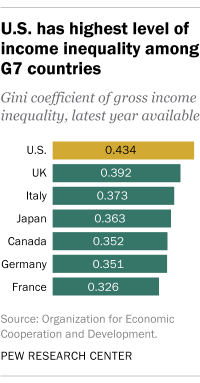
Amongst the top 5% of households – those with incomes of at least $248,729 in 2018 – their share of all U.Due south. income rose from 16% in 1968 to 23% in 2018.
Income inequality in the U.S. is the highest of all the G7 nations, according to data from the Organization for Economic Cooperation and Evolution. To compare income inequality across countries, the OECD uses the Gini coefficient, a unremarkably used mensurate ranging from 0, or perfect equality, to 1, or complete inequality. In 2017, the U.S. had a Gini coefficient of 0.434. In the other G7 nations, the Gini ranged from 0.326 in France to 0.392 in the UK.
Globally, the Gini ranges from lows of near 0.25 in some Eastern European countries to highs of 0.5 to 0.6 in countries in southern Africa, according to World Banking company estimates.
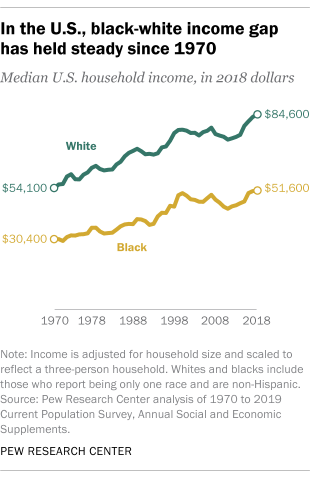
The black-white income gap in the U.S. has persisted over fourth dimension. The divergence in median household incomes between white and black Americans has grown from about $23,800 in 1970 to roughly $33,000 in 2018 (equally measured in 2018 dollars). Median black household income was 61% of median white household income in 2018, upwardly modestly from 56% in 1970 – but downwards slightly from 63% in 2007, earlier the Keen Recession, according to Electric current Population Survey data.
Overall, 61% of Americans say there is too much economical inequality in the country today, but views differ by political party and household income level. Amidst Republicans and those who lean toward the GOP, 41% say there is too much inequality in the U.S., compared with 78% of Democrats and Autonomous leaners, a Pew Enquiry Middle survey conducted in September 2019 found.
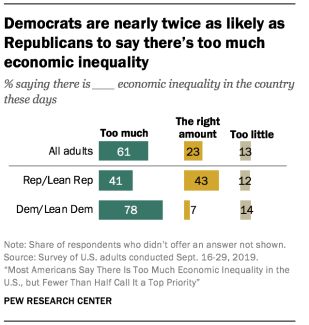
Across income groups, U.S. adults are about equally likely to say in that location is likewise much economical inequality. But upper- (27%) and middle-income Americans (26%) are more likely than those with lower incomes (17%) to say that there is virtually the right amount of economic inequality.
These views also vary by income within the two political party coalitions. Lower-income Republicans are more likely than upper-income ones to say at that place'due south too much inequality in the country today (48% vs. 34%). Among Democrats, the reverse is true: 93% at upper-income levels say there is besides much inequality, compared with 65% of lower-income Democrats.
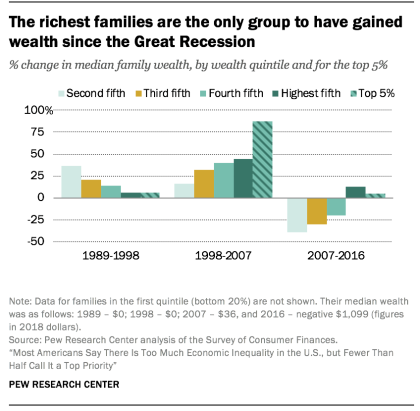
The wealth gap between America'south richest and poorer families more than than doubled from 1989 to 2016, according to a contempo analysis by the Center. Another way of measuring inequality is to look at household wealth, as well known as net worth, or the value of assets endemic past a family, such as a home or a savings account, minus outstanding debt, such as a mortgage or student loan.
In 1989, the richest 5% of families had 114 times as much wealth as families in the 2d quintile (one tier above the everyman), at the median $2.3 1000000 compared with $20,300. By 2016, the top 5% held 248 times equally much wealth at the median. (The median wealth of the poorest xx% is either zero or negative in most years nosotros examined.)
The richest families are also the only ones whose wealth increased in the years later the starting time of the Smashing Recession. From 2007 to 2016, the median internet worth of the top 20% increased thirteen%, to $1.two million. For the top 5%, it increased by 4%, to $4.8 million. In contrast, the median net worth of families in lower tiers of wealth decreased by at least 20%. Families in the 2nd-lowest fifth experienced a 39% loss (from $32,100 in 2007 to $19,500 in 2016).
Eye-grade incomes have grown at a slower charge per unit than upper-tier incomes over the past five decades, the same assay constitute. From 1970 to 2018, the median center-form income increased from $58,100 to $86,600, a gain of 49%. By comparison, the median income for upper-tier households grew 64% over that fourth dimension, from $126,100 to $207,400.
The share of American adults who alive in middle-income households has decreased from 61% in 1971 to 51% in 2019. During this time, the share of adults in the upper-income tier increased from 14% to 20%, and the share in the lower-income tier increased from 25% to 29%.

Source: https://www.pewresearch.org/fact-tank/2020/02/07/6-facts-about-economic-inequality-in-the-u-s/
Post a Comment for "The Richest 20 Percent of U.s. Families Earn"